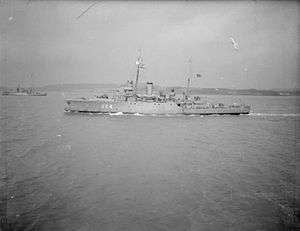HMS Hebe (J24)
HMS Hebe was one of 21 Halcyon-class minesweepers built for the Royal Navy in the 1930s.
 Hebe photographed from HMS Rodney, October 1940 | |
| History | |
|---|---|
| Name: | HMS Hebe (J24) |
| Builder: | Devonport Dockyard |
| Launched: | 28 October 1936 |
| Commissioned: | 1937 |
| Fate: | Mined 22 November 1943 |
| General characteristics | |
| Class and type: | Halcyon-class minesweeper |
| Displacement: |
|
| Length: | 245 ft 3 in (74.75 m) o/a |
| Beam: | 33 ft 6 in (10.21 m) |
| Draught: | 9 ft (2.7 m) |
| Installed power: |
|
| Propulsion: |
|
| Speed: | 16.5 knots (30.6 km/h; 19.0 mph) |
| Range: | 6,000 nmi (11,000 km; 6,900 mi) at 10 knots (19 km/h; 12 mph) |
| Complement: | 157 |
| Armament: |
|
Design and description
The Halcyon class was designed as a replacement for the preceding Hunt class and varied in size and propulsion. Hebe displaced 875 long tons (889 t) at standard load and 1,330 long tons (1,350 t) at deep load. The ship had an overall length of 245 feet 3 inches (74.8 m), a beam of 33 feet 6 inches (10.2 m) and a draught of 9 feet (2.7 m).[1] The ship's complement consisted of 80 officers and ratings.[2]
She was powered by two Parsons geared steam turbines, each driving one shaft, using steam provided by two Admiralty three-drum boilers. The engines produced a total of 1,750 shaft horsepower (1,300 kW) and gave a maximum speed of 16.5 knots (30.6 km/h; 19.0 mph). Hebe carried a maximum of 252 long tons (256 t) of fuel oil that gave her a range of 6,000 nautical miles (11,000 km; 6,900 mi) at 10 knots (19 km/h; 12 mph).[3]
Hebe was armed with two QF 4-inch (10.2 cm) anti-aircraft guns. She was also equipped with eight .303-inch (7.7 mm) machine guns. Later in her career, the rear 4-inch gun mount was removed as were most of the .303 machine guns, while one quadruple mount for Vickers .50 machine guns was added as were up to four single or twin mounts for 20 mm Oerlikon antiaircraft guns. For anti-submarine escort, her minesweeping gear could be exchanged for around 40 depth charges.[4]
Construction and career
Hebe was built at the Devonport Dockyard and she was commissioned in 1936. Her pennant number was N 24, later J 24. The ship served during the evacuation of Dunkirk, where she rescued 365 officers and men, and sent a gig to rescue Lord Gort on 29 May 1940.[5] She later saw service in the Mediterranean Sea based at Malta as part of 14th/17th Minesweeper Flotilla. She participated in Operation Harpoon (where she was hit by a very long range 152mm shell fired by the Italian cruiser Raimondo Montecuccoli), Operation Torch, and the invasion of Pantelleria. She was sunk by a mine off Bari on 22 November 1943. Thirty-seven men from her complement were lost with the ship.[6]
References
- Lenton, pp. 251–52
- Chesneau, p. 63
- Lenton, p. 252
- Chesneau, p. 63; Lenton, p. 252
- Naval Obituaries - Harold Biles The Telegraph, 6 April 2011
- "Royal Navy casualties, killed and died, November 1943". www.naval-history.net. Retrieved 27 October 2015.
Bibliography
- Chesneau, Roger, ed. (1980). Conway's All the World's Fighting Ships 1922–1946. Greenwich, UK: Conway Maritime Press. ISBN 0-85177-146-7.
- Colledge, J. J.; Warlow, Ben (2006) [1969]. Ships of the Royal Navy: The Complete Record of all Fighting Ships of the Royal Navy (Rev. ed.). London: Chatham Publishing. ISBN 978-1-86176-281-8.
- Lenton, H. T. (1998). British & Empire Warships of the Second World War. Annapolis, Maryland: Naval Institute Press. ISBN 1-55750-048-7.